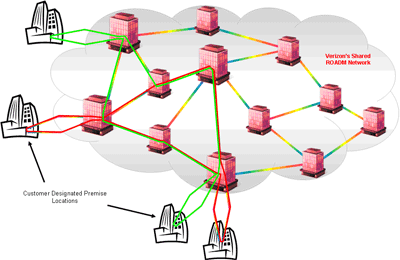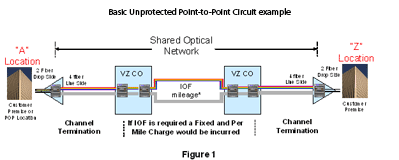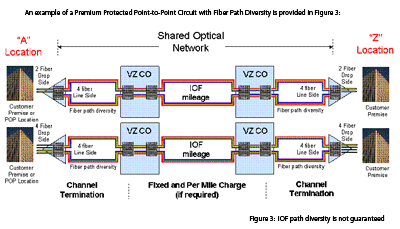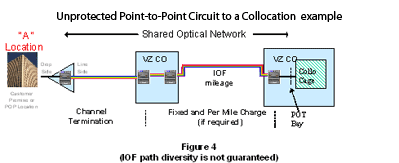Optical Wave Service
Why Verizon?
As demand in network capacity continues to increase to support high bandwidth services, Verizon's Optical Wave Service (OWS) is a great solution for interconnectivity. OWS provides for a fully managed, point-to-point circuit over a wavelength that runs across Verizon's ROADM-based shared network infrastructure.
" While every service has its particular advantages and disadvantages, OWS provides some of the most cost-effective and secure options available for high capacity, sustained throughput between two systems requiring low latency, low jitter, and high availability."
Product Manager - Vicma Lamarche
- Overview
- Service Details
- Diagram
- Take Action
The service provides a path for each point-to point-circuit and can be used to connect a Customer designated Premise to another Customer designated Premise, a Customer designated Premise to a Customer Point of Presence (POP) location, or to interconnect POP locations.
In addition to the traditional Optical Wave Service, Optical Wave Service-Optical Extension (OWS-OE) is now available. Optical Wave Service-Optical Extension is an enhancement to our traditional Wave service that provides a direct fiber drop connectivity solution. OWS-OE is an innovative variation on the traditional OWS service and is often referred to as our “edgeless wave” product. Optical Wave Service – Optical Extension (OWS-OE) delivers on Verizon's promise of Simple, Faster, Better, and at lower price points. Optical Wave Service – Optical Extension does not require powered electronics at the customer premise end. This innovative design results in 10 Gbps optical connectivity at near half the cost of our traditional service. |
 |
The volume of data storage and transmission throughout the world continues to increase rapidly. While a wide range of factors drive the overall increase, some particular items lead to the deployment of applications that utilize extremely high data rate transmission between systems. Many services are available that allow high data rate transmission, such as Public Internet Service, Internet Protocol Virtual Private Network (IP VPN), Private Internet Protocol (PIP), Virtual Private LAN Service (VPLS), Asynchronous Transfer Mode (ATM), and various Private Line options such as Synchronous Optical Network (SONET), Ethernet, Storage Transport Services, and Wavelength Services. Deciding which service is right for you depends on a variety of factors: maximum bandwidth requirements, bandwidth variability, number of destinations, concentration of data flows between locations, latency, jitter, availability, security requirements, and cost.
High-Bandwidth Service Drivers
Traditionally, extremely high data-rate transmissions, such as 2.5 Gigabits per second (Gbps), 10 Gbps and 40Gbps, were used internally by facility-based service providers. Over the past several years, there has been a continued increase in demand by wholesale service providers, large Internet Service Providers (ISPs) and the Wireless segment to expand their network reach where they do not own facilities. Optical Wavelength Service allows them to extend their network reach without the costly capital expense (capex) and with minimal impact in operational expense (opex) to manage and maintain that network.
Optical Wavelength Services provides
- Protocol Independent / Transparent Circuits
- Ease of Network Scalability
- Lower CAPEX and OPEX
- Network Management Integration
- Supplier Stability
Applications that Benefit from High-Bandwidth Services:
- LAN and WAN connectivity
- High-speed data transfer
- Storage Area Networks
- Continuous Internet access
- Medical imaging transport
- Financial data transactions
- Off-site Data Backup
- Disaster Recovery
Non-Transparent Versus Transparent
SONET is a standard for optical signal transport. In the last half decade, SONET has become the foundation of high-capacity data communications. SONET contains both a synchronous payload envelope and transport overhead. Among other items, the transport overhead allocates bytes for section and line data communications channels (DCCs) to support the transfer of operations, administration, maintenance, and provisioning (OAM&P) information and bytes for automatic protection switching (APS) signals. When Verizon offers services over a SONET-based infrastructure, Verizon needs to terminate the transport overhead in order to manage the network and service. In this situation, the customer cannot use the SONET transport overhead bits end-to-end for their own application. As such, the service is considered to be a non-transparent service. While non-transparent services have been acceptable to many customers, customers with larger, interconnecting networks require transparent wavelengths for seamless network management integration and more control over their network.
Transparent wavelengths, sometimes called protocol independent wavelengths, use a digital wrapper that allocates bytes for forward error correction (FEC), overhead, and payload. Today there are vendor-proprietary solutions, but work is well underway for standards-based digital wrapper service known as ITU-T G.709. Because Verizon can perform network monitoring of the wavelength using the digital wrapper, the carrier does not modify the payload. For example, if a customer places a SONET signal in a transparent wavelength, Verizon will manage the network and service using the digital wrapper overhead, leaving the digital wrapper payload (including the SONET transport overhead) untouched. As such, the customer can use the SONET transport overhead bytes however they wish. Some customers prefer this configuration because they want to use the SONET transport overhead to access their own OAM&P information across the DCC or to pass the APS bytes to control their own protection functions. Other customers may desire transparent wavelengths to support transport of LAN Physical Layer (LAN- PHY) which, due to its slightly higher line rate than WAN PHY, cannot be supported on non-transparent services.
Verizon will interface the following protocols over Optical Wave Service:
2.5 Gbps Wave Interfaces:
- OC48 with Transparent Synchronous Frame
10 Gbps Wave Interfaces:
- OC192 with Transparent Synchronous Frame
- 10 Gbps LAN-PHY
- 10 Gbps LAN-PHY with Semi-Transparency
- 10 Gbps WAN-PHY
10 Gbps Channelized Wave Interfaces (non-multiplexer end):
- OTU-2 (with 192 assignable STS1s)
10 Gbps Channelized Wave Mux Port Interfaces:
- OC3/OC3c
- OC12/OC12c
- Gigabit Ethernet
- 1Gbps Fibre Channel
- 1Gbps FICON
Optical Wave Service-Optical Extension is available with the following configurations:
2.5 Gbps Wave Interfaces:
- OC48 Transparent Synchronous Frame
10 Gbps Wave Interfaces:
- OC192 Transparent Synchronous Frame
- 10 Gbps LAN-PHY
- 10 Gbps LAN-PHY with Semi-Transparency
- 10 Gbps WAN-PHY
Channel Terminations provide the fiber local loop Facilities for the communications path between the Customer designated Premises or POP and the Serving Wire Center of that Premises. Channel Terminations are available on a Protected or Unprotected basis depending on the protocol being transmitted and the level of redundancy required. OWS-OE is only available as Basic Unprotected.
Basic Unprotected Channel Terminations
2-fiber interface: Unprotected 1:0 ("one for zero") provides no card or route protection. An unprotected Service provides no optical protection of the signal from the Customer. With Basic Unprotected Channels, if a card failure or a fiber cut should occur along the optical signal paths, the Channel cannot reroute and thus fails.
Premium Protected Channel Terminations
2-fiber interface: Protected 1+1 ("one plus one") provides for card protection but does not provide fiber path diversity. In 1+1 protection scheme, a working card is paired with a protect card of the same type. A copy of the signal is transmitted respectively on both the working and the paired protect card. At the receiver side, equipment will determine whether to switch to the protect card based on signal. If a working card fails or if there is a loss of signal along the working path the receiver end will switch to the protect card. When the failure on the working card is resolved, traffic can be set to automatically revert to the working card. However, since both working and protect Circuits could be routed down the same fiber path, a single fiber cut could result in both optical signal paths being interrupted, and thus a failed Circuit.
4-fiber interface: Provides for two Circuit paths via distinct cards, but does not perform any switching protection nor does it provide for fiber path diversity. This allows Customer to apply its own protection scheme within its network equipment. Although each Circuit path is provided over distinct card electronics, since both Circuits could be routed down the same fiber path, a single fiber cut could result in both optical signal paths being interrupted.
Premium Protected Channel Terminations with Fiber Path Diversity
With Fiber Path Diversity (FPD), the working and protect Circuits are sent down diverse fiber paths in the local loop from the Customer designated Premises back to the Serving Wire Center. FPD can be requested for the local loop on either end or on both ends of the OWS Circuit. The risk of a fiber cut interrupting service is greatly diminished. IOF path diversity is not guaranteed.
2-fiber interface: Provides for the greatest level of protection for the Customer in that it provides for 1+1 card protection, as stated previously under Premium Protect Channel Terminations, along with Fiber Path Diversity.
4-fiber interface: Provides for two Circuit paths via distinct cards, as well as FPD. In this case, Customer must apply its own protection scheme within its network equipment.
Availability
Optical Wavelength Service is available throughout Verizon's footprint where suitable facilities exist or can be placed. Since Optical Wavelength Service is a high capacity customized network, it is deployed upon Customer request. Where Verizon does not have sufficient facilities and equipment available to meet a Customer's request, Verizon may provide the service subject to additional charges.
Pricing
Optical Wave Service is provided only on a private carriage (contractual) basis under a Master Services Agreement arrangement between the Customer and Verizon. Pricing for new orders of this service is handled on a contractual basis. Please contact us or call your Account Manager to discuss your particular needs.
Note: The terms and conditions of certain of the services described above are set forth in full detail on a private carriage basis (Private Carriage Services). For all Private Carriage Services, the above summary is provided for your information and reference only. However, the actual terms, conditions, restrictions, limitations and the like for Private Carriage Services will be those set forth in the agreement between the customer and Verizon for such Private Carriage Service and shall govern over any inconsistent provisions set forth herein. All services are not available in all areas, and are subject to availability of facilities and equipment.



Optical Extension



To learn more about this service, please contact us or call your Account Manager today.
